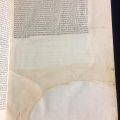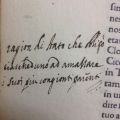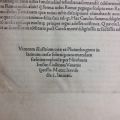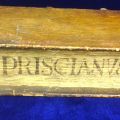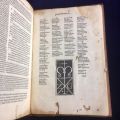This week's blog post is authored by Nina Mamikunian. Nina is a reference librarian in Research, Instruction, and Outreach Services at the University Library.
Before Johannes Gutenberg developed the printing press and moveable type in the 1440s, books in Western Europe were handwritten, copied, and illustrated one at a time by scribes. This made books extremely expensive to produce and relatively rare to own. However, with the advent of the printing press and moveable type, multiple copies of a book could be made quickly (by medieval standards) and for far less money. Suddenly, books were booming, with major print centers in countries all across Europe.
Books printed before 1501 are called incunabula. This term comes from the Latin word meaning cradle or infancy, and refers to the time period in which these books were made, as in: these books were made while printing was still in its infancy. The cutoff point of 1500 is relatively arbitrary; there was no major change or development in the process that happened in that year. In 1643, Bernhard von Mallinckrodt wrote a pamphlet about printed books to celebrate the two hundredth anniversary of Gutenberg’s achievements and described those early books and broadsheets using the word incunabula. We’ve called them that ever since.
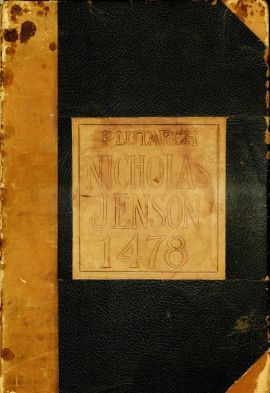 Special Collections and Archives has thirty-nine incunabula in its holdings. Today, scholars and researchers often look at early printed books to discover the processes by which the books were made and who made them. The materiality of the book—the paper, the binding, its size—as well as such things as printer’s devices (the logo of the printer), signature marks (letters and numbers at the bottom of the page), marginalia, and bookplates of previous owners can reveal a book’s origins and history. Among the library's collection are works by notable early printers such as Nicholas Jenson and Lucantonio Giunta, both of whom had shops in Venice. Jenson is known for developing the roman typeface, which was much easier to read than the blackletter, or Gothic, script that was used throughout much of Europe. We know that these particular books were made by these particular printers because their names are in the colophons or they included their printer’s device.
Special Collections and Archives has thirty-nine incunabula in its holdings. Today, scholars and researchers often look at early printed books to discover the processes by which the books were made and who made them. The materiality of the book—the paper, the binding, its size—as well as such things as printer’s devices (the logo of the printer), signature marks (letters and numbers at the bottom of the page), marginalia, and bookplates of previous owners can reveal a book’s origins and history. Among the library's collection are works by notable early printers such as Nicholas Jenson and Lucantonio Giunta, both of whom had shops in Venice. Jenson is known for developing the roman typeface, which was much easier to read than the blackletter, or Gothic, script that was used throughout much of Europe. We know that these particular books were made by these particular printers because their names are in the colophons or they included their printer’s device.
While moveable type was becoming popular throughout Europe, woodcuts were often used for illustrations and initial letters. Much like the handwritten manuscripts, these initials and illustrations were to be painted by hand at a later date and not in the print shop. Sometimes the initial letters were to be done entirely by hand without a woodcut. In many copies that survive today, it is not unusual to see large blank spaces where that illustration was meant to be.
Although the printing press allowed for multiple copies of a book to be made, through time each book became incredibly unique. Even elements that at first seem like a negative—bookworm damage, repaired paper, blank or incomplete initials—add to a book’s individual history and serve to remind us of the human endeavors connected to that history. The incunabula collection is a valuable resource for understanding the history of printing and book design.



![Sermones de t[em]p[or]e et de sanctis. An example of blackletter, or Gothic, script and Johann Emerich of Speier’s printer’s device. Johann Emerich printed work for Lucantonio Giunta. BV 4254.3.B47 1495 Sermones de t[em]p[or]e et de sanctis. An example of blackletter, or Gothic, script and Johann Emerich of Speier’s printer’s device. Johann Emerich printed work for Lucantonio Giunta. BV 4254.3.B47 1495](https://library.csun.edu/sites/default/files/styles/collections_resize/public/Exhibitions/image_1_resize.jpg?itok=inSqdD1R)
![Sermones de t[em]p[or]e et de sanctis. Handmade paper can sometimes have imperfections, such as the creases and thin spots at the edge of this page. BV 4254.3.B47 1495 Sermones de t[em]p[or]e et de sanctis. Handmade paper can sometimes have imperfections, such as the creases and thin spots at the edge of this page. BV 4254.3.B47 1495](https://library.csun.edu/sites/default/files/styles/collections_resize/public/Exhibitions/image_2_resize.jpg?itok=fw8bn2qZ)
![Sermones de t[em]p[or]e et de sanctis. A missing initial letter. BV 4254.3.B47 1495 Sermones de t[em]p[or]e et de sanctis. A missing initial letter. BV 4254.3.B47 1495](https://library.csun.edu/sites/default/files/styles/collections_resize/public/Exhibitions/image_3_resize.jpg?itok=CPnPFyoo)
![Sermones de t[em]p[or]e et de sanctis. A woodcut initial letter. BV 4254.3.B47 1495 Sermones de t[em]p[or]e et de sanctis. A woodcut initial letter. BV 4254.3.B47 1495](https://library.csun.edu/sites/default/files/styles/collections_resize/public/Exhibitions/image_4_resize.jpg?itok=qFrypnJl)
![Sermones de t[em]p[or]e et de sanctis. Lucantonio Giunta’s printer’s device. BV 4254.3.B47 1495 Sermones de t[em]p[or]e et de sanctis. Lucantonio Giunta’s printer’s device. BV 4254.3.B47 1495](https://library.csun.edu/sites/default/files/styles/collections_resize/public/Exhibitions/image_5_resize.jpg?itok=cG1KK-FZ)
